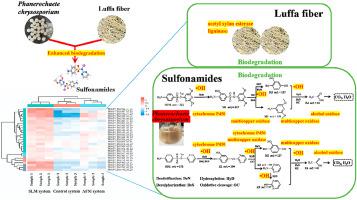Chemosphere ( IF 8.1 ) Pub Date : 2020-12-04 , DOI: 10.1016/j.chemosphere.2020.129194 Lan Zhang , Nicholas W. Johnson , Yun Liu , Yu Miao , Ruihuan Chen , Hong Chen , Qian Jiang , Zhongpei Li , Yuanhua Dong , Shaily Mahendra

|
The overuse of antibiotics and subsequent enrichment of antibiotic resistant microbes in the natural and built environments is a severe threat to global public health. In this study, a Phanerochaete chrysosporium fungal-luffa fiber system was found to efficiently biodegrade two sulfonamides, sulfadimethoxine (SDM) and sulfadizine (SDZ), in cow urine wastewater. Biodegradation pathways were proposed on the basis of key metabolites identified using high performance liquid chromatography coupled with quadrupole-time-of-flight mass spectrometry (HPLC-QqTOF-MS). Transcriptomic, metabolomic, and free radical analyses were performed to explore the functional groups and detailed molecular mechanisms of SDM and SDZ degradation. A total of 27 UniGene clusters showed significant differences between luffa fiber and luffa fiber-free systems, which were significantly correlated to cellulose catabolism, carbohydrate metabolism, and oxidoreductase activity. Carbohydrate-active enzymes and oxidoreductases appear to play particularly important roles in SDM and SDZ degradation. Electron paramagnetic resonance (EPR) spectroscopy revealed the generation and evolution of  OH and R
OH and R during the biodegradation of SDM and SDZ, suggesting that beyond enzymatic degradation, SDM and SDZ were also transformed through a free radical pathway. Luffa fiber also acts as a co-substrate to improve the activity of enzymes for the degradation of SDM and SDZ. This research provides a potential strategy for removing SDM and SDZ from agricultural and industrial wastewater using fungal-luffa fiber systems.
during the biodegradation of SDM and SDZ, suggesting that beyond enzymatic degradation, SDM and SDZ were also transformed through a free radical pathway. Luffa fiber also acts as a co-substrate to improve the activity of enzymes for the degradation of SDM and SDZ. This research provides a potential strategy for removing SDM and SDZ from agricultural and industrial wastewater using fungal-luffa fiber systems.
中文翻译:

Phanerochaete chrysosporium – Luffa纤维系统在转录组水平上对磺酰胺的生物降解机理
在自然和建筑环境中过度使用抗生素以及随后增加对抗生素产生抗药性的微生物对全球公共健康构成了严重威胁。在这项研究中,Phanerochaete chrysosporium真菌-丝瓜纤维系统被发现可以有效地降解牛尿废水中的两种磺酰胺,磺胺二甲嘧啶(SDM)和磺胺二嗪(SDZ)。基于高效液相色谱和四极杆飞行时间质谱(HPLC-QqTOF-MS)鉴定的关键代谢产物,提出了生物降解途径。进行了转录组学,代谢组学和自由基分析,以探索SDM和SDZ降解的官能团和详细的分子机制。共有27个UniGene簇显示丝瓜纤维和无丝瓜纤维系统之间的显着差异,这与纤维素分解代谢,碳水化合物代谢和氧化还原酶活性显着相关。碳水化合物活性酶和氧化还原酶似乎在SDM和SDZ降解中起特别重要的作用。电子顺磁共振(EPR)光谱揭示了电子的产生和演化
 SDM和SDZ生物降解过程中的OH和R ,表明除了酶降解外,SDM和SDZ还通过自由基途径转化。丝瓜纤维还充当共底物,以改善用于降解SDM和SDZ的酶的活性。这项研究提供了使用真菌丝瓜纤维系统从农业和工业废水中去除SDM和SDZ的潜在策略。
SDM和SDZ生物降解过程中的OH和R ,表明除了酶降解外,SDM和SDZ还通过自由基途径转化。丝瓜纤维还充当共底物,以改善用于降解SDM和SDZ的酶的活性。这项研究提供了使用真菌丝瓜纤维系统从农业和工业废水中去除SDM和SDZ的潜在策略。











































 京公网安备 11010802027423号
京公网安备 11010802027423号